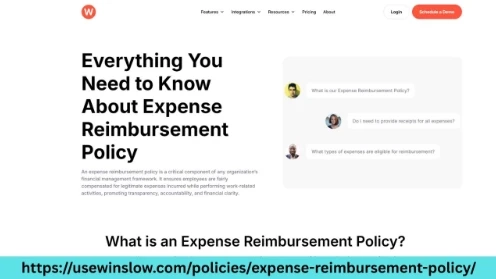Running a small business or operating as a self-employed entrepreneur involves managing a wide range of financial responsibilities. Among these, reimbursing employees—or yourself—for business expenses is a vital practice. However, many small business owners overlook the importance of having a formal expense reimbursement policy, leading to confusion, errors, and even tax issues. That’s why Winslow is here to help you understand how to create expense reimbursement policy that’s clear, fair, and compliant.
In this comprehensive step-by-step guide, we’ll walk you through everything you need to know about setting up an effective expense reimbursement policy, especially suited for small business owners and entrepreneurs.
Why You Need an Expense Reimbursement Policy
Before we get into the step-by-step process, let’s understand the why. Having an expense reimbursement policy ensures:
- Financial clarity between employer and employee
- Accurate budgeting and forecasting
- IRS compliance (for tax-deductible expenses)
- Transparency and trust within your team
- Efficient tracking of business-related spending
For self-employed entrepreneurs, a policy also helps in creating consistent rules for your own expense tracking, especially if you plan to expand or hire freelancers and staff.
Step 1: Define What Qualifies as a Business Expense
The first step in creating an effective policy is defining what counts as a reimbursable expense. The IRS considers a business expense reimbursable if it is:
- Ordinary: Common and accepted in your industry
- Necessary: Helpful and appropriate for your business
Examples might include:
- Travel and transportation
- Meals and lodging during business trips
- Office supplies
- Client entertainment
- Training and development courses
- Software subscriptions
Winslow recommends clearly listing each eligible category to avoid confusion later.
Step 2: Decide Who Can Submit Reimbursement Requests
In small businesses, roles often overlap. Clearly define who is eligible to submit expenses for reimbursement. This could be:
- Full-time employees
- Freelancers and contractors
- The business owner (you)
If you’re a solo entrepreneur, this might sound redundant, but defining it in writing helps you when filing taxes or presenting your finances to investors or lenders.
Step 3: Set Clear Guidelines for Submissions
Once eligibility is defined, the next part is detailing how and when to submit reimbursement claims. Consider including:
- Time frame for submission (e.g., within 30 days of expense)
- Required documentation (receipts, mileage logs, invoices)
- Preferred format (physical forms, spreadsheets, or expense tracking apps)
- Approval process (Who checks and verifies the expense?)
Using Winslow’s smart financial templates can make the tracking and submission process easier for small business teams.
Step 4: Establish Approval Procedures
Your policy should clearly define who reviews and approves reimbursement requests. In a small business, this might just be you or your bookkeeper. Larger teams might include department heads or office managers.
Define:
- Approval timeline
- Who has final authority
- Conditions for partial or denied reimbursements
Having this structure avoids conflicts and ensures accountability.
Step 5: Set Limits and Spending Caps
To prevent abuse or overspending, your policy should set reasonable limits on expenses. For instance:
- Meal reimbursement capped at $50 per day
- Mileage reimbursement based on IRS rates
- Lodging capped at a specific rate per night
- Travel only reimbursed for economy-class airfare
Even self-employed entrepreneurs can benefit from setting these limits to maintain a budget. Winslow suggests using historical spending data to set realistic thresholds.
Step 6: Determine Reimbursement Methods and Timing
Explain how and when reimbursements will be issued. Options include:
- Direct deposit
- PayPal or other payment platforms
- Added to next payroll cycle
- Monthly reimbursements
Specify whether employees will be reimbursed in full or partially, and outline the standard time frame (e.g., within 14 business days of approval).
Step 7: Outline Tax Implications
It’s essential to make sure your policy complies with IRS guidelines, especially if you want expenses to be tax-deductible.
For reimbursements to be non-taxable for employees:
- They must be part of an accountable plan
- Expenses must be business-related
- Employees must return excess reimbursements
- Proper documentation must be maintained
Winslow encourages small business owners to consult a tax professional to ensure full compliance.
Step 8: Use Technology for Streamlined Processing
Manual tracking can lead to errors and lost receipts. Tools like accounting software or expense-tracking apps can streamline the process. Winslow provides solutions that integrate seamlessly with major financial platforms, helping entrepreneurs:
- Digitize and categorize receipts
- Automate approvals
- Monitor expense trends
- Generate reimbursement reports for taxes or audits
Step 9: Communicate and Distribute the Policy
Once your expense reimbursement policy is finalized, make sure it's easily accessible to your team. Share it via:
- Employee handbooks
- Company intranet
- Email distribution
- Onboarding packets for new hires
Hold a quick training session if needed to explain how it works. For solo entrepreneurs, keep a copy for your records and for any future partners or team members.
Step 10: Review and Update the Policy Regularly
Your business will evolve, and so should your policies. Schedule a yearly review of your reimbursement policy to:
- Adjust limits based on inflation or business growth
- Add or remove reimbursable categories
- Improve clarity and streamline workflows
Winslow advises creating a version history and updating dates to maintain transparency.
Final Thoughts
Creating a well-defined expense reimbursement policy isn’t just for large corporations. For small businesses and self-employed entrepreneurs, it provides structure, supports growth, and ensures financial accuracy. By following this step-by-step guide from Winslow, you’ll set yourself up for smoother operations, greater trust with your team, and better tax readiness.
Don’t leave your business finances to guesswork. Create an expense reimbursement policy that works for your size, your team, and your vision. And if you need help getting started, Winslow has templates, tools, and expert resources tailored for small businesses like yours.


